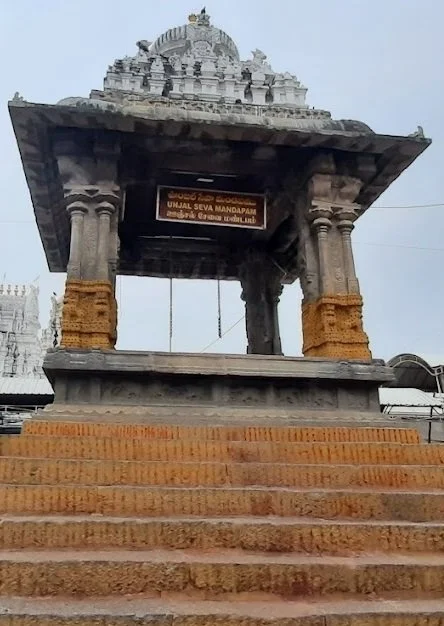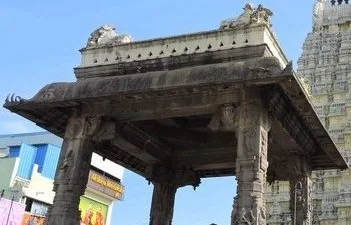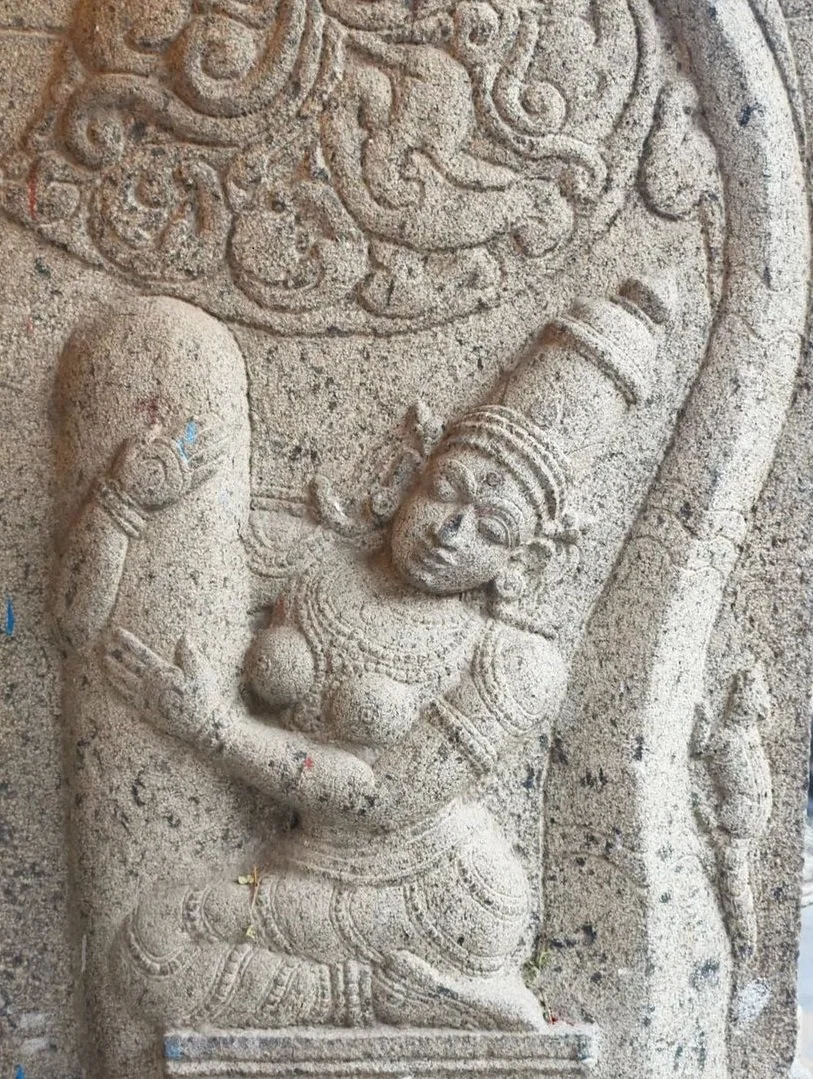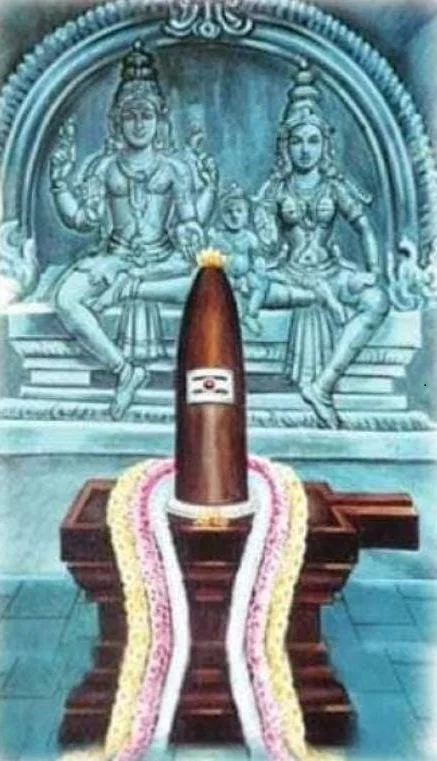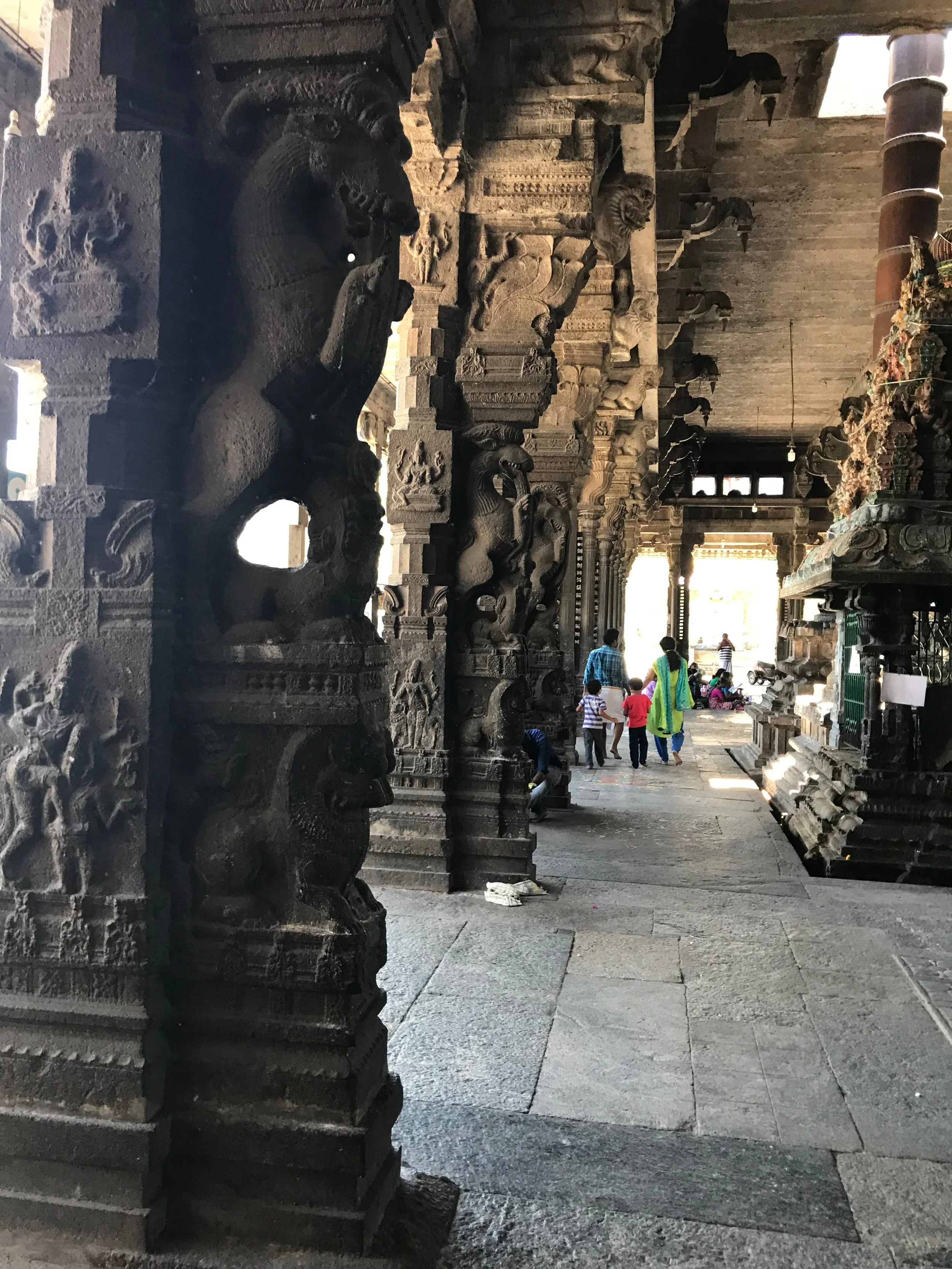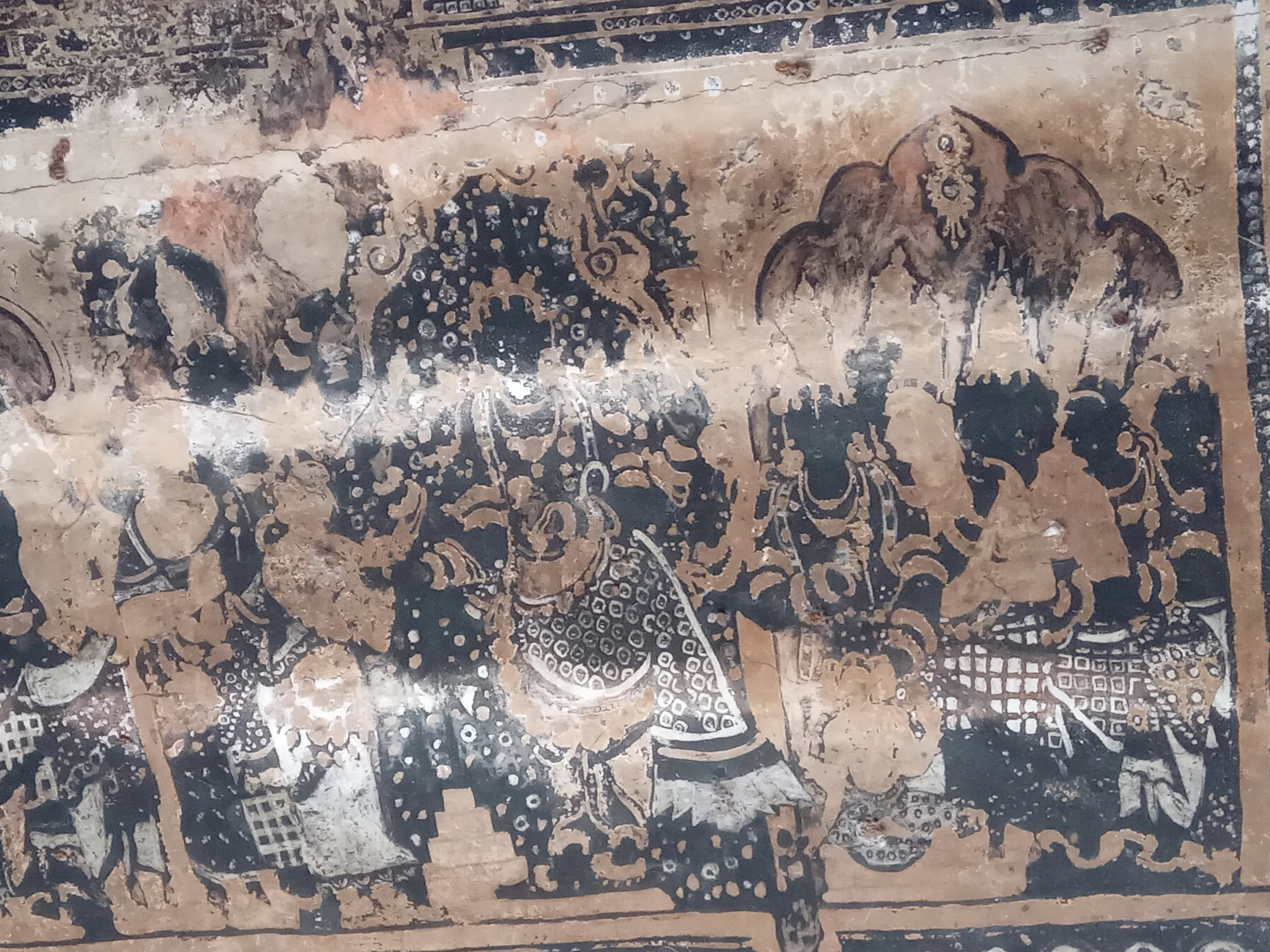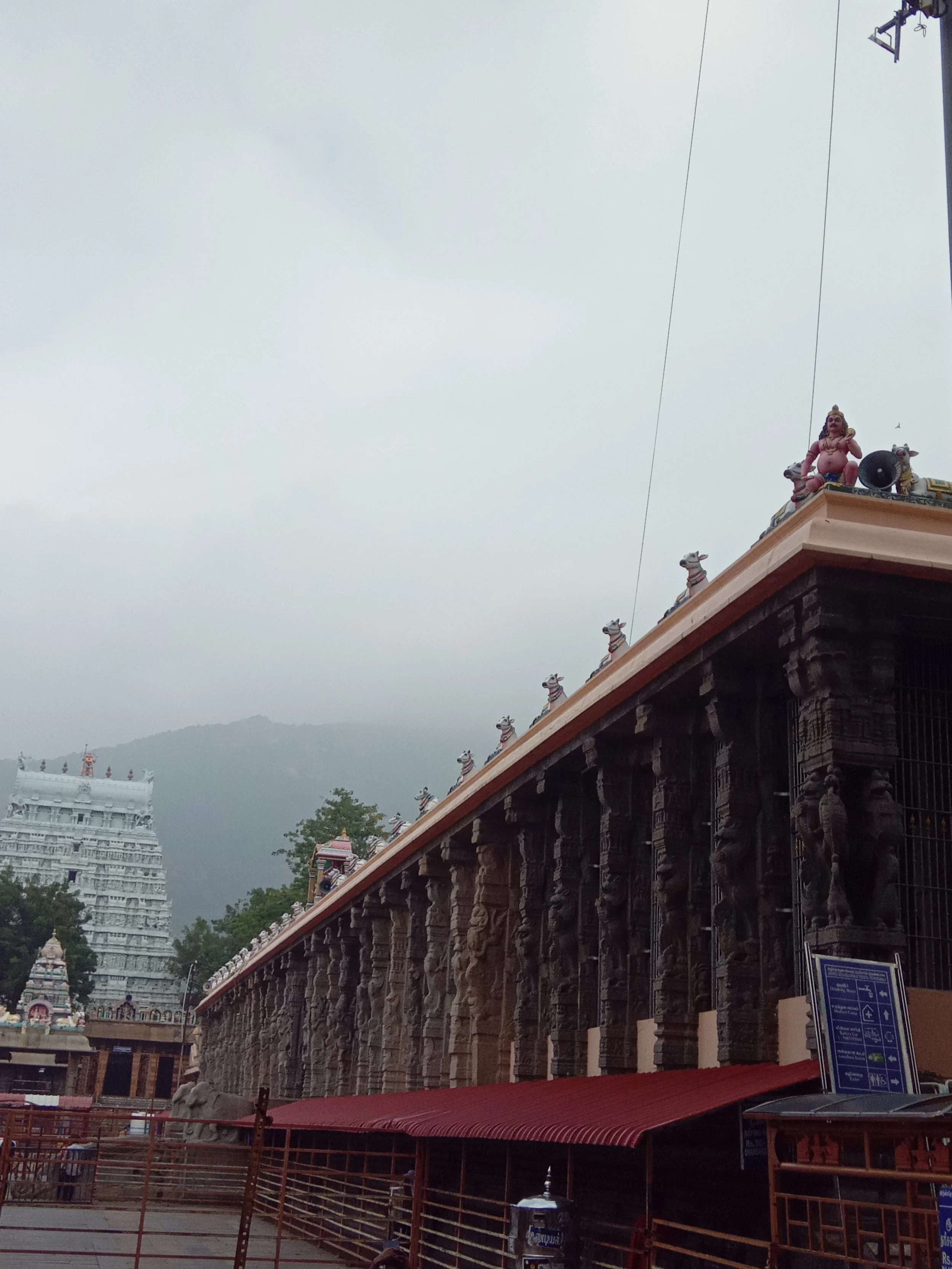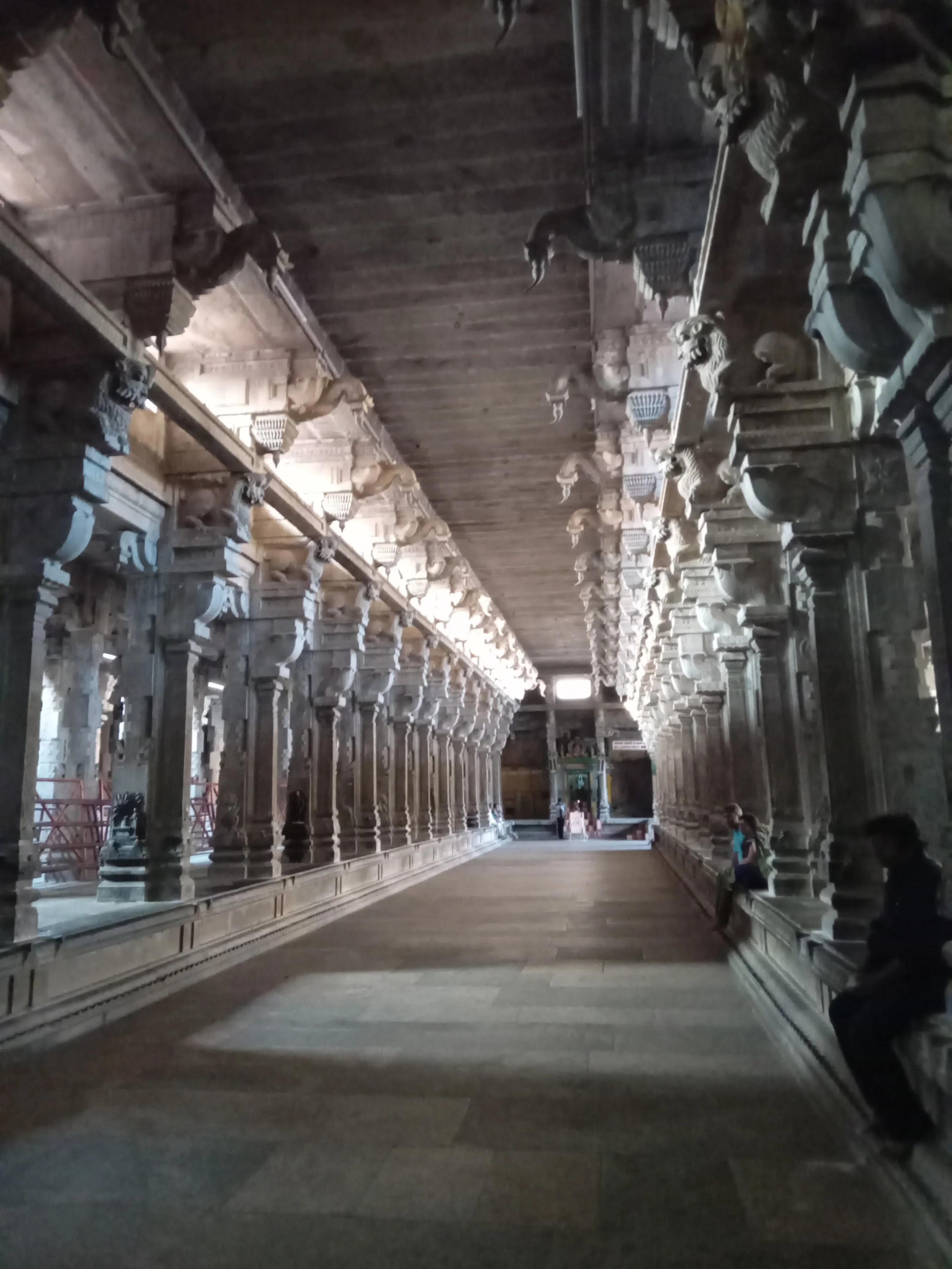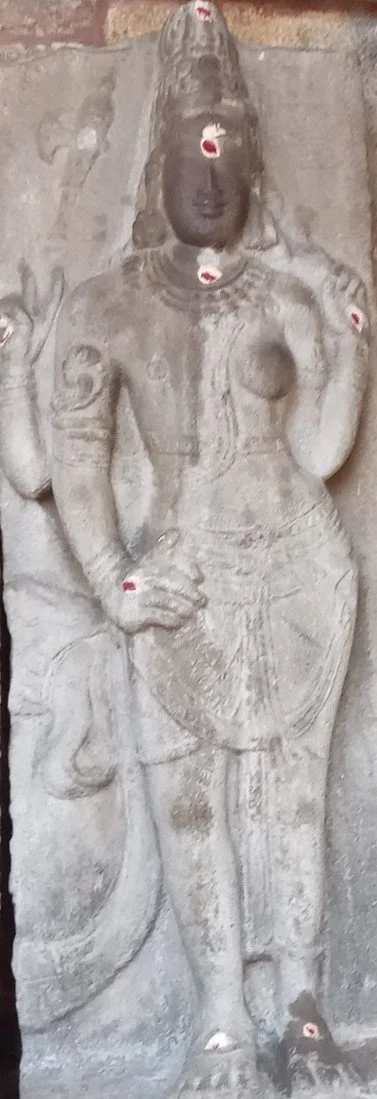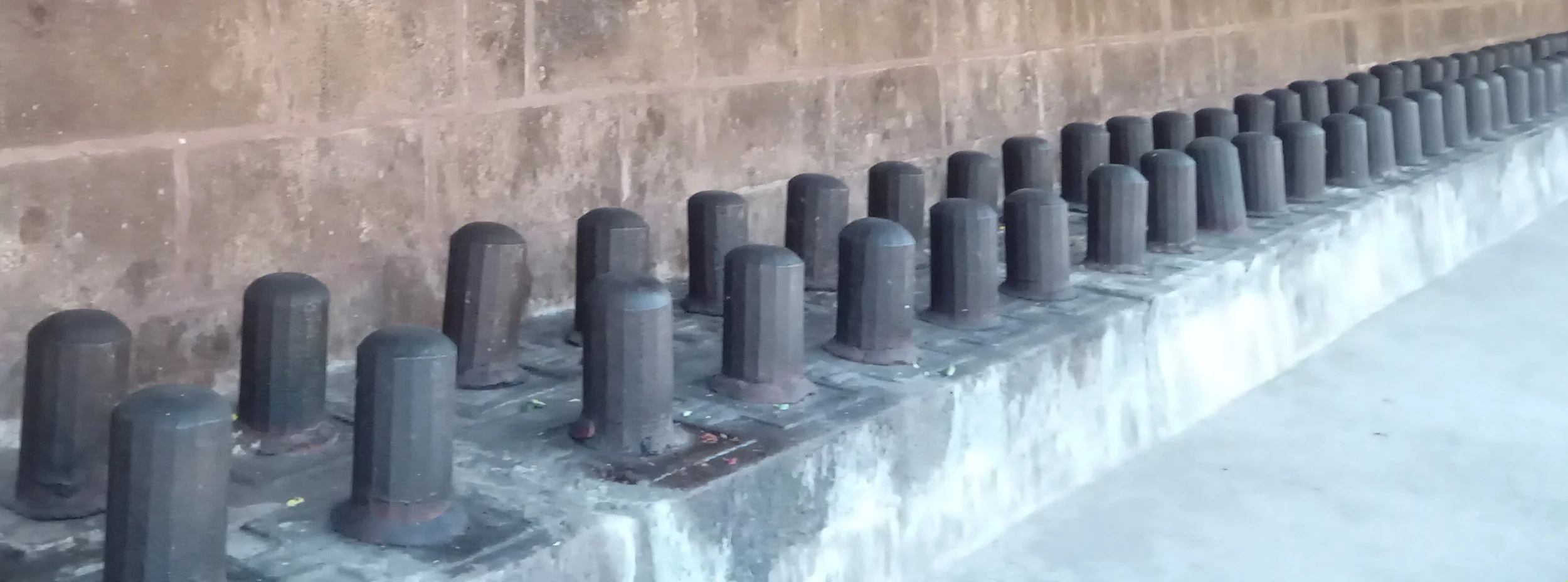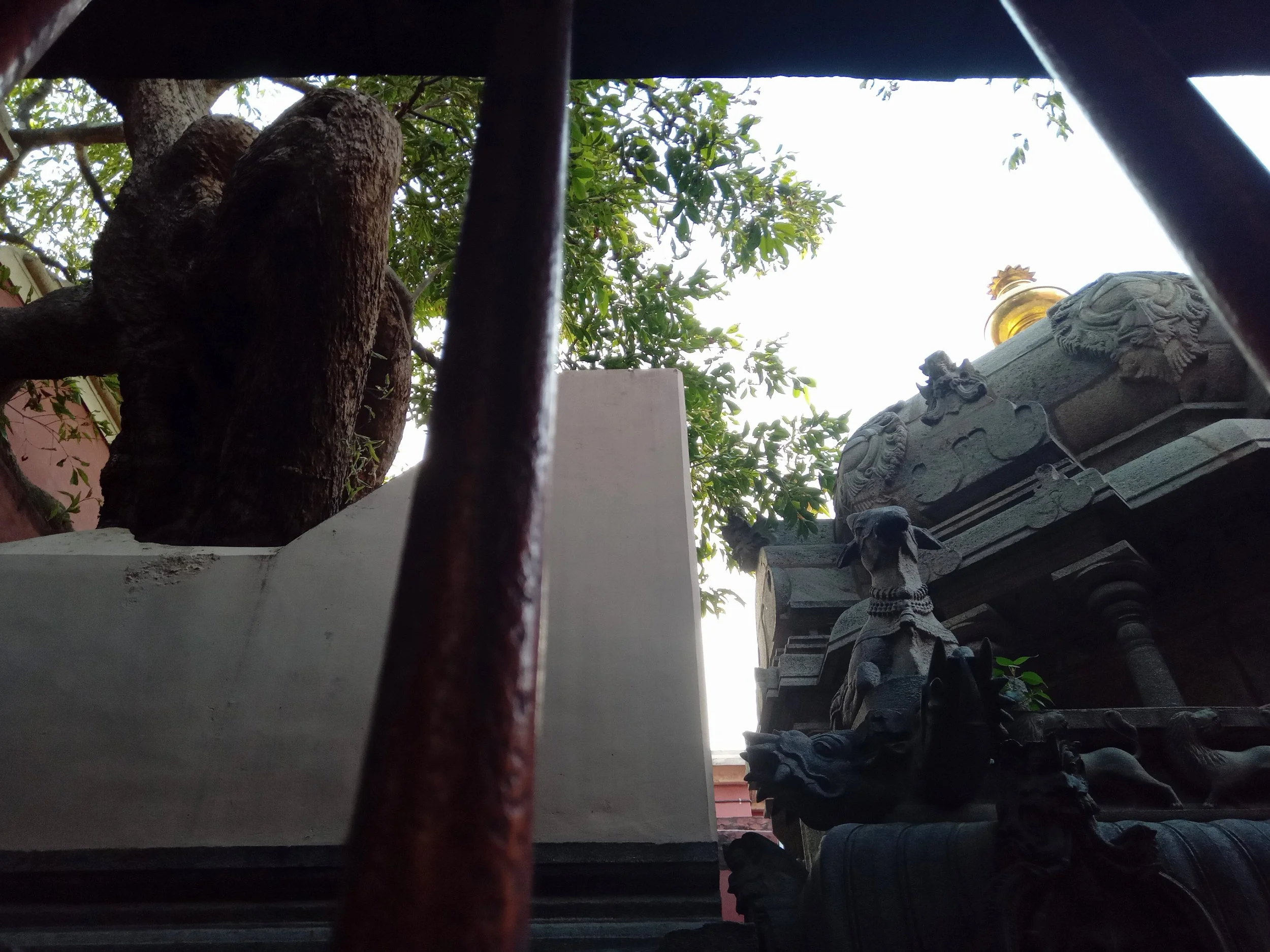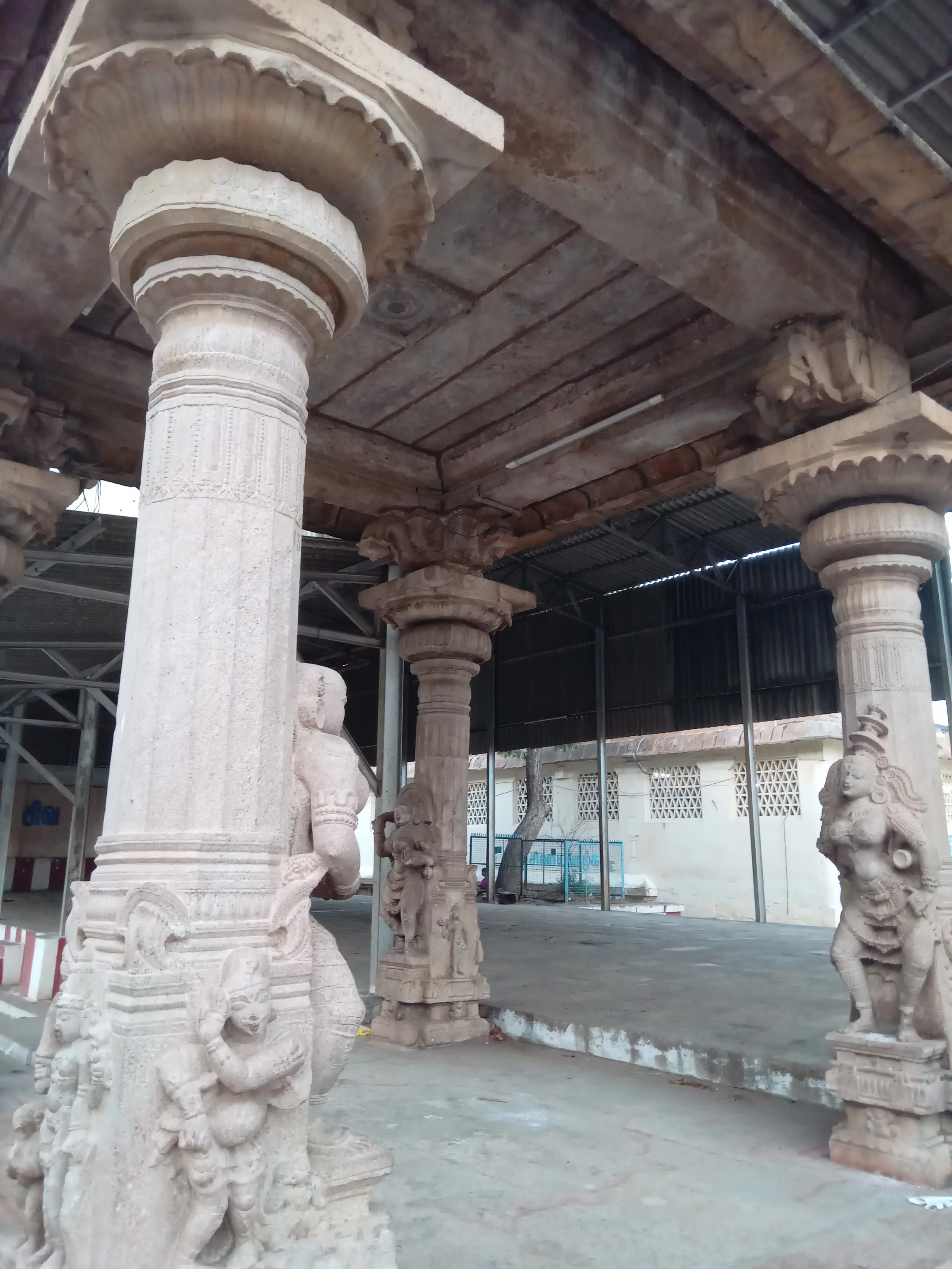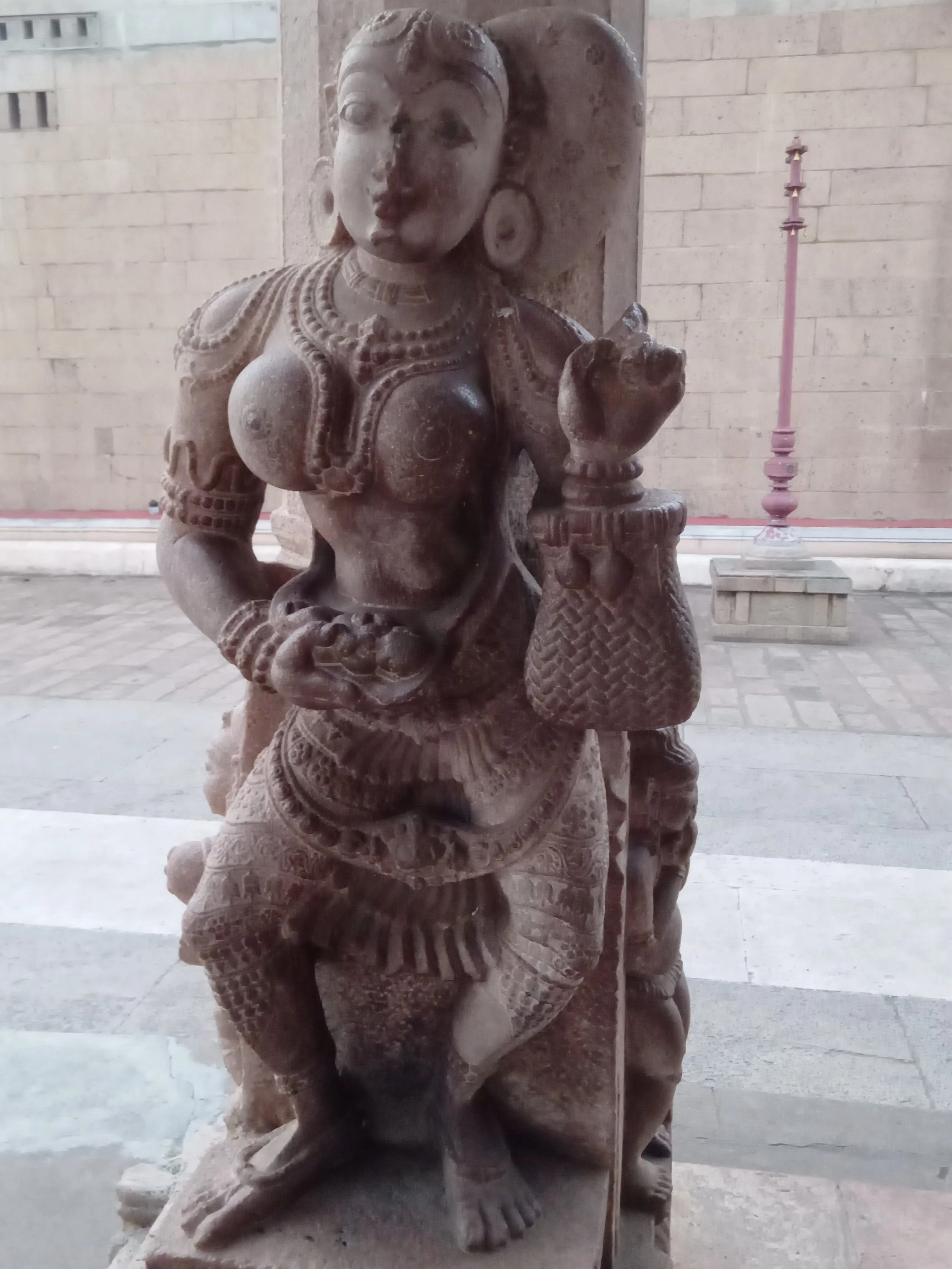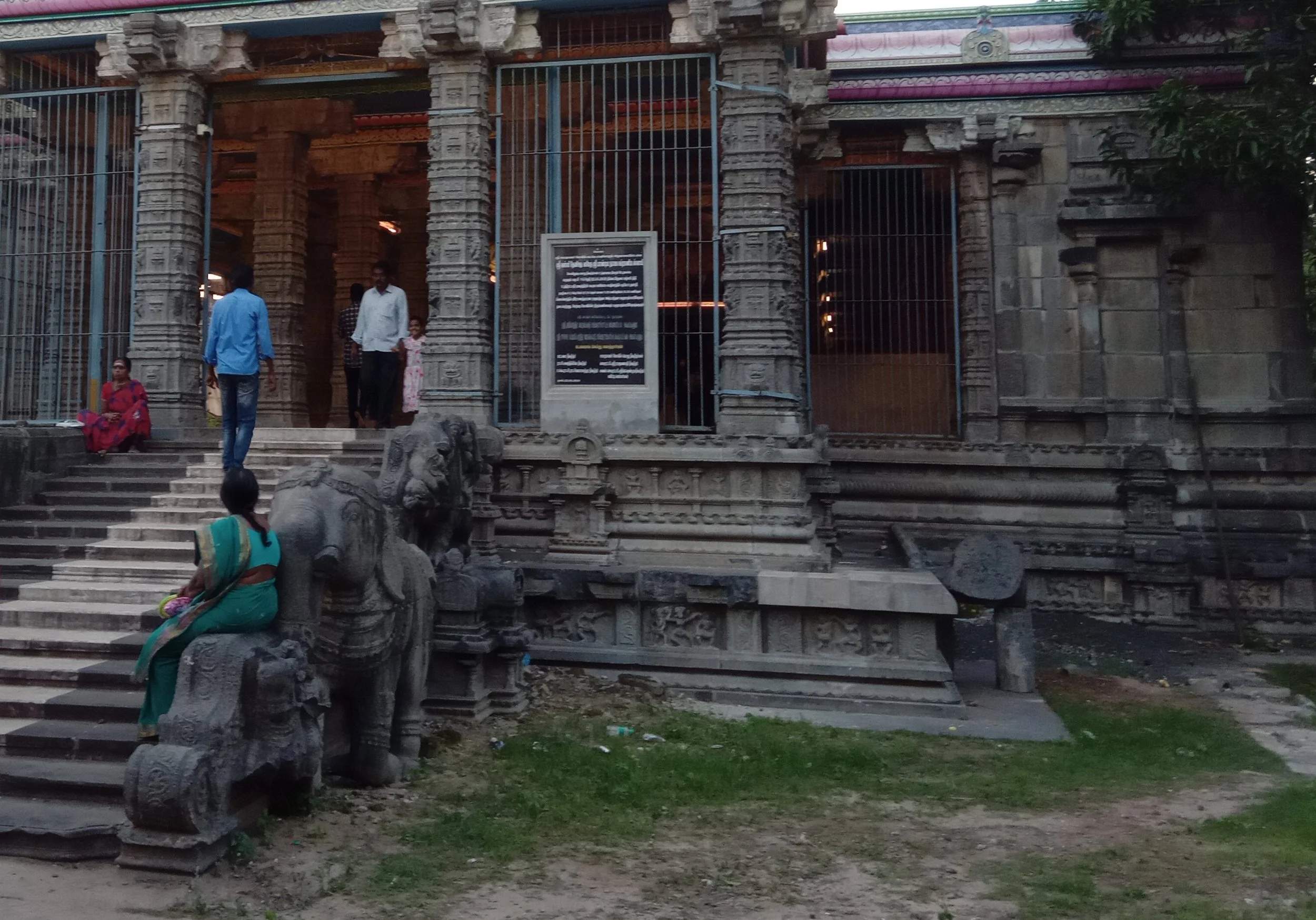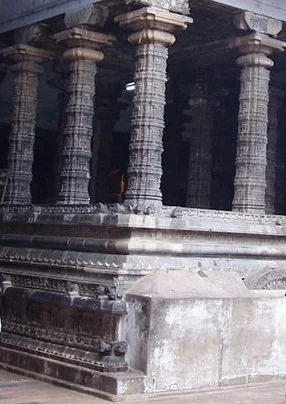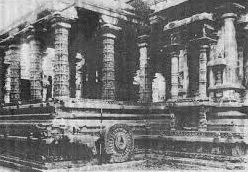Elemental Shiva temples in South India
Many special temples all over India, but let’s focus here on the essentially five pancha-bhoota Shiva temples in South India: (i) Kalahastishwara in Sri Kalahasti (vaayu or air); (ii) Ekambareshwara in Kanchipuram (bhumi or earth); (iii) Arunachaleshwara in Thiruvannamalai (agni or fire); (iv) Jambukeshwara in Thiruvanaikaval near Trichy (varuna or water); and (v) Thillai Nataraja in Chidambaram (akasha or ether).
Keep in mind that most of the living Hindu temples don’t allow photography inside the premises. While I have tried to include some pictures here and there for your reference below, my main focus is on the written details for your guidance (indispensable in this regard, both during the actual visit and for these notes: George Michell’s excellent, comprehensive Southern India).
Sri Kalahasti
Located in the same district as the Tirupati Balaji shrine, the identity and even the name of the town (denoting three staunch non-human devotees of Shiva—sri meaning spider, kala serpent, hasti elephant) is inextricably intertwined with that of the Kalahastishwara temple, with the deity here being Shiva rather than Vishnu. Nestled between the Swarnamukhi river (independent of the more widely-known Krishna and Godavari rivers) and a branch of the eastern ghats, the area is also renowned for the production of kalamkaris.
Two recent constructions from circa 2017-18 you should be aware of beforehand: the giant seated Shiva-Parvati statues overlooking the town from a hilltop, and the new entrance tower that replaced the gaali gopuram (installed by Krishnadevaraya in 1516 which collapsed in 2010). And another point you should know of before entering the temple premises: while the other temples in this list also largely disallow photography inside they at least allow you to carry your phone in a pocket—the one in Sri Kalahasti is strictest prohibiting even pocket-carrying your phone. (We left ours in our hotel room.)
On entering from the South side, after you go past the first hallway, you will come to an open courtyard with an Indian-laurel tree. Look at the large mandapa nearby—note the high basement and the finely carved columns.
From here follow the crowds towards the sanctuary inside: if this is the first of the Vijayanagara style-temples you’ve visited, which was the case with me, be amazed at the scale of the doorways, the high ceilings, and the expansive columned halls. Take some time looking at the carvings on the columns—you might as well, given the duration you are required to wait in line for darshan. (Multiply what you see below by hundredfold to get a proper idea of the scale and dimension.)
Now get ready for the inner sanctuary: and once you are in, in the few seconds allotted to you, see if you could notice the elongated linga often likened to the shape of an elephant trunk, on a square pedestal. (The shape of the pedestal is significant because the square corresponds to the divine world while the circle connotes the human world.)
Representative
You are by no means done yet—make your way to the Parvati shrine nearby where she is revered as gnaana-prasoonaamba: she stands in tribhanga, a graceful posture with a slight bend in three places—knee, hip and shoulders-neck.
Also notable: the Dakshinamurti shrine and the patala Ganapati in the outer hallway where a subterranean Ganesha is revered down below.
Kanchipuram
This renowned city, one of the most ancient and storied in South India, has so many other notable temples—very deserving of a separate, stand-alone post coming soon—but I’d like to concentrate on the Ekambareshwara temple here first.
The Ekambareshwara is the largest temple in so-called “Shiva Kanchi” sprawling almost 23 acres—and you could consider your journey beginning at the high mandapa with slender columns perched on the street outside the entrance gopuram.
The south entrance gopuram, a 17th century structure, rises almost 200 feet crowned by a barrel-vaulted roof featuring no less than 11 kalasa finials.
South gopuram (image courtesy Sai Sreevidya)
South gopuram from within (image courtesy Sai Sreevidya)
Next you come to an open area facing a long mandapa—inside which are located various shrines, bali peetha altars and so forth, which we’ll come to later.
If your focus is on the main darshan first as was the case with us, enter this long mandapa, and again follow the crowds towards the sanctuary. Here you will come to a hall with a gateway in front. Now on your left, perched on a basement, sits a glass case with a withered tree trunk clad in silver (the outer carving showing Kamakshi clutching the linga)—the accompanying sign indicates it as the ancient mango tree trunk under which Parvati (Kamakshi) worshipped Shiva.
Ancient mango tree trunk in a glass case outside main shrine
All over the temple though, you will see carvings in relief showing Kamakshi’s ardent devotion to Shiva: the Parvati-Shiva mythology is filled with stories of determination and persistence in love, and this particular story only adds to this great tradition.
Representative: linga made of earth/sand
Mango tree in open courtyard representing Kamakshi’s ardor: with accompanying shrine
In the colonnades sits a row of several multi-faceted lingas (including a sahasra linga).
And now for the interiors of promised long mandapa in the front.
Inside long mandapa in front, featuring various shrines and altars, with the relevant column carvings (image courtesy Sarah Welch)
Image courtesy Vinayaraj
Thiruvannamalai
The Arunachaleshwara temple here escalates the size further, spread out over almost 25 acres, with the spectacular east entrance gateway (the Rajagopuram) nearly 220 feet high.
The Arunachaleshwara from our hotel
Model of the compound showing Arunachala hill, near the ticket office inside
Ceiling above: weathered mural of Shiva-Parvati wedding with celestials in attendance (note the white pyramidal altar at the bottom)
Thousand-pillared hall
Representative: note the flame on top, signifying agni
Thiruvanaikaval near Trichy
The Jambukeshwara here was the least crowded among the big Shiva temples I encountered so far.
Mandapa in front with fluted columns
The minute we walked inside, I noticed the relatively deserted interiors: and the resultant sense of peace, tranquility.
Next we came to a kind of cross-roads with giant piers featuring suitably massive carvings on the columns.
Now on to the main shrine for darshan: a singular experience for me, seeing such a renowned Hindu shrine not crowded at all. We pretty much had the inner subterranean sanctuary all to ourselves: the priest showed us the small varuna linga on the floor, forever washed by a naturally flowing eternal spring.
Suitably awash, we came back outside then, circumambulating—noticing the various columns, and finally the jambu rose-apple tree in the open but barred courtyard beside the inner sanctuary.
On a slab leaning against the wall: Ardhanareeshwara
Jambu rose-apple tree beside the inner sanctuary topped by a kalasa finial
We continued walking: then approached a mandapa with carvings on the columns.
A young mother out on the town with stylish hairbun and earrings: the baby in her right hand, and a fashionable handbag in the left
Parvati worshipping Shiva (consecrated in The Jambukeshwara as her guru)
Chidambaram
The Thillai Nataraja is the dance temple—where art and creativity and the divine come together in exhilarating ways—as we were reminded when groups of tween dancers in resplendent Bharatanatyam attire formed prominent part of the crowd which flowed like a broad river towards the inner sanctuary.
Incredibly, people filled the doorways and the wide corridors entirely—after a while, we found ourselves on a basement in front of the main shrine. Looking to our left, we saw a Vishnu shrine facing east—housing a giant reclining form of Vishnu. We entered the Vishnu line, but remarkably everyone there was turned towards the Shiva shrine facing south—with Nataraja and Parvati sculptures in a glass case in front.
Before realizing fully, we went in and circled all around the reclining Vishnu—finally ending up outside at the edge of the basement, with everyone there craning their necks to glimpse Nataraja in the main shrine. I gave up after awhile, but we decided to come back later, noting that the management here was different—no regimented lines, but a kind of free for all (which had its advantages as we realized later, such as potentially more personalized attention from the priests).
We returned the next morning—with far fewer people at the main shrine. We stood in the open courtyard and I noted for the first time the two hutlike enclosures that comprise the ritualistic center of the temple—the chit and the kanaka sabha. Only a lot later could I correctly identify which was which (the larger, brighter one housing Nataraja-Parvati being chit and the smaller, weathered one where we go in to see them, the kanaka sabha).
That’s when a priest pointed out to us the akasha lingam up on the second level of the colonnade—small, squat, turmeric on top, a white cloth over the square pedestal. No entry for visitors up there, and you could only glimpse it if you stood in a particular area of the open courtyard. (The first time, in the morning, it took me a few minutes of concentrated gazing to spot: when I came back in the evening the same day, I could see it much more clearly under lights.)
We then went inside (the kanaka sabha)—no “special” tickets here in this temple unlike the government-managed ones, a matter of pride for the priests here that they are managing things on their own—and in the dark interiors past the gilded columns, we saw crystal clear this time Nataraja dancing, one foot up, and one arm counterbalancing in the characteristic Nataraja way.
Notably, although the sculpture is motionless in actuality, the moment you glimpse it the sense is of movement—the limbs, the facial expression—proof at least of the exquisite sculptural art. This is Nataraja in his oft-repeated “cosmic dance”: but more specifically in ananda tandava, or dance of delight (as opposed to the very different urdhva tandava pose depicted in the Nritya Mandapa which we’ll come to later). On his left: red-clad Parvati standing in tribhanga; on his right, a quartz crystal sphatika linga (larger than the akasha one outside—apropos which, George Michell says the akasha linga is invisible, but the priest insists it’s the one on the second level of the colonnade he showed us).
We went outside next, circumambulating clockwise, when we approached the Shiva Kamasundari shrine opposite a tank (the Shiva Ganga koneru), one of the oldest goddess shrines in South India.
The shrine was practically empty—and we had an incredibly private darshan—Parvati here standing in tribhanga again, a slight welcoming smile on her face.
In the outer hallway, in one of the side aisles: ceiling paintings depicting the Bhikshatana and Mohini legend.
The bottom two panels depict the Bhikshatana-Mohini legend (multi-armed Bhikshatana in white, Mohini the dark brown figure here in a diaphanous sari—images courtesy Sai Sreevidya)
Next up on the path: a surprisingly spacious Subrahmanya shrine with Hoysala-style pillars (where he sits on the peacock as usual, but I could notice the posture here well perhaps because of the understated flower-decoration, with the feet visible to us).
Back inside the main Nataraja building, we went on a quest to find the Nritya Sabha George Michell mentions, and stumbled upon a modest Bharatanatyam performance in one of the corridor corners—perhaps a clue that we were getting closer or at least on the right track—and sure enough, the target of our quest lay at the end of the long, long corridor.
The Nritya Sabha is envisioned as a chariot with wheels—the archival/representative picture/s below might not do it justice, but in actuality the elaborately carved columns and Shiva in urdhva tandava pose inside, one leg raised high up, one arm counterbalancing above the head (as opposed to the ananda tandava in the main shrine mentioned earlier)—proved plenty rewarding.
Nritya Sabha archival: note the chariot-wheels, later partly covered by reinforcements in cement
